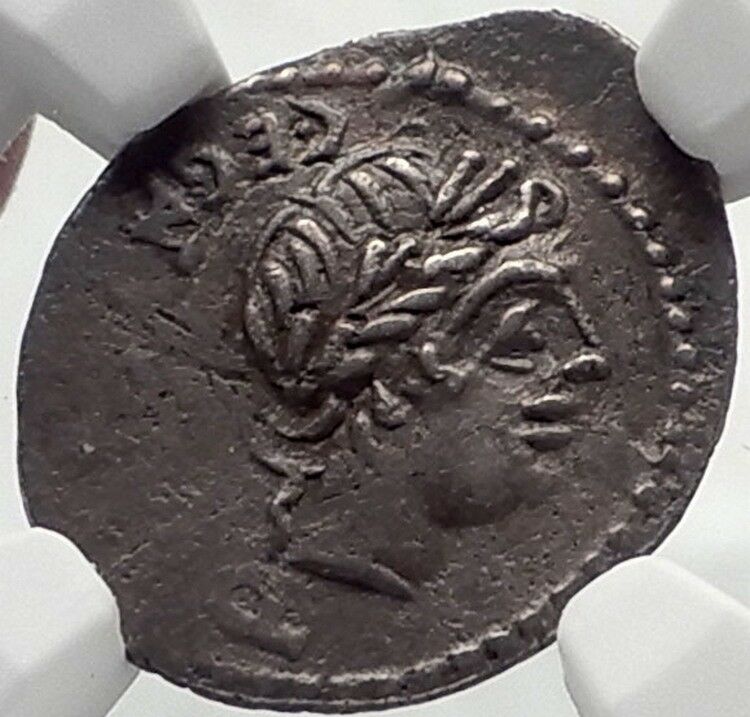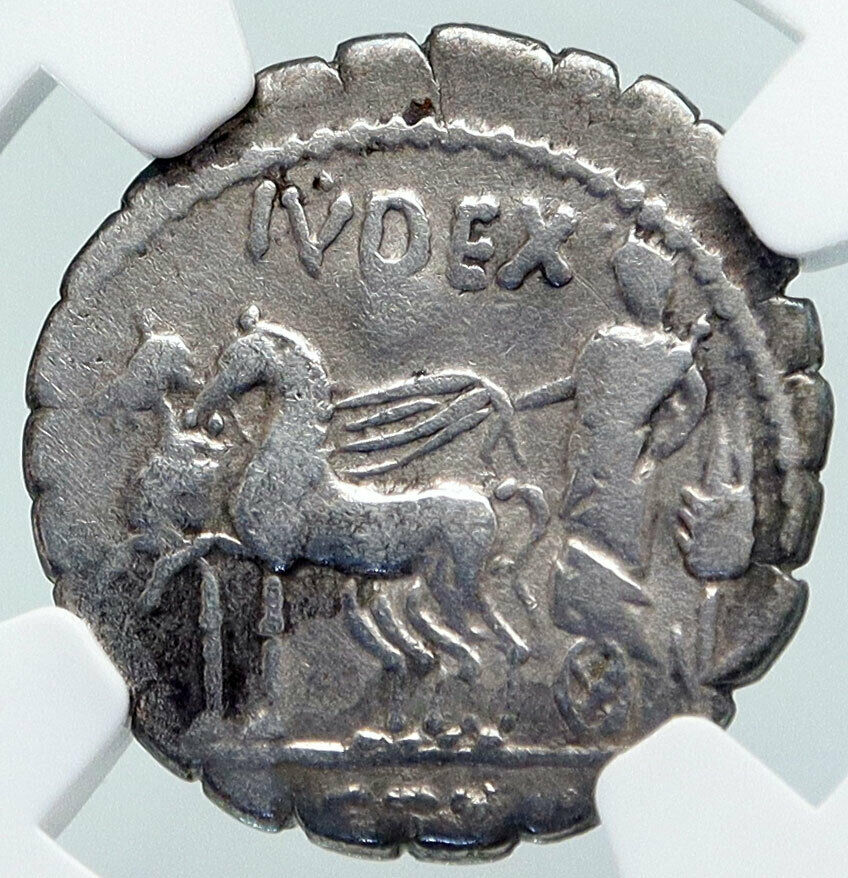|
Roman Republic Anonymous moneyer
Silver Quadrigatus 24mm (6.17 grams) Rome mint, circa 225-212 B.C.
Reference: Anonymous 23; B.M.C. 78-99; Syd 64, a, b
Certification: NGC Ancients Ch XF Strike: 5/5 Surface: 2/5 4529164-006
Laureate head of Janus.
Jupiter in quadriga driven by Victory right, ROMA incuse on solid tablet below.
You are bidding on the exact item pictured, provided with a Certificate of Authenticity and Lifetime Guarantee of Authenticity.
The quadrigatus was a medium-sized silver coin produced by the Roman Republic during the 3rd century BC. The obverse featured a young janiform bust and the reverse featured Victory driving a quadriga (four-horse chariot), giving the coin its name, with the inscription “ROMA” below.
The coin weighed about 6.8 grams (6 scruples), consistent with a didrachma. The coin was minted from c. 241 to 235 BC until shortly before the introduction of the denarius (211 BC). Gold coins of similar style were issued at this time (staters and half-staters) which featured the same obverse type as the quadrigatus and the reverse type of two soldiers performing an oath over a third soldier holding pig, with the inscription “ROMA” below. The choice of Janus for these coins is believed to coincide with the closing of the doors of the Temple of Janus, indicating the absence of warfare, a rare occasion. Michael Crawford, however, has suggested that the janiform head represents the Dioscuri, since Janus is usually a mature and bearded figure.
Roman-era historians such as Livy and Plutarch often refer to these early coins as denarii, but modern numismatic references consider these coins as anonymous Roman silver, produced before the standardization of the denarius around 211 B.C. The name quadrigatus comes from the quadriga or four-horse chariot on the reverse, which was the prototype for the most common designs used on Roman silver coins for the next 150 years.
The victoriatus was a later coin of the same fabric that was valued at half a quadrigatus (3 scruples).
In Roman mythology, Janus is the god of gates, doors, doorways, beginnings, endings and time. Most often he is depicted as having two heads, facing opposite directions; one head looks back at the last year while the other looks forward to the new, simultaneously into the future and the past.
Janus was usually depicted with two heads facing in opposite directions. According to a legend, he had received the gift to see both future and past from the god Saturn in reward for the hospitality received. Janus-like heads of gods related to Hermes have been found in Greece, perhaps suggesting a compound god.
The Romans associated Janus with the Etruscan deity Ani. Several scholars suggest that he was likely the most important god in the Roman archaic pantheon. He was often invoked together with Iuppiter (Jupiter).
According to Macrobius and Cicero, Janus and Jana (Diana) are a pair of divinities, worshipped as the sun and moon, whence they were regarded as the highest of the gods, and received their sacrifices before all the others.
In general, Janus was the patron of concrete and abstract beginnings of the world (such as the religion and the gods themselves), the human life, new historical ages, and economical enterprises. He was also the god of the home entrance (ianua), gates, bridges and covered and arcaded passages (iani) named after him.
He was frequently used to symbolize change and transitions such as the progression of past to future, of one condition to another, of one vision to another, the growing up of young people, and of one universe to another. He was also known as the figure representing time because he could see into the past with one face and into the future with the other. Hence, Janus was worshipped at the beginnings of the harvest and planting times, as well as marriages, deaths and other beginnings. He was representative of the middle ground between barbarity and civilization, rural country and urban cities, and youth and adulthood.
Numa in his regulation of the Roman calendar called the first month Januarius after Janus, at the time the highest divinity. Numa also introduced the Ianus geminus (also Janus Bifrons, Janus Quirinus or Portae Belli) , a passage ritually opened at times of war, and shut again when Roman arms rested. It formed a walled enclosure with gates at each end, situated in the Roman Forum which had been consecrated by Numa Pompilius. In the course of wars, the gates of the Janus were opened, and in its interior sacrifices and vaticinia were held to forecast the outcome of military deeds. The doors were closed only during peacetime, an extremely rare event. Livy wrote in his Ab urbe condita that the doors of the temple had only been closed twice since the reign of Numa: firstly in 235 BC after the first Punic war and secondly in after the battle of Actium in 31 BC. A temple of Janus is said to have been consecrated by the consul Gaius Duilius in 260 BCE after the Battle of Mylae in the Forum Holitorium. The four-side structure known as the Arch of Janus in the Forum Boarium dates to the 4th century CE.
In the Middle Ages, Janus was also taken as the symbol of Genoa, whose Latin name was Ianua, as well as of other European communes.
The Roman Republic (Latin: Res Publica Romana) was the period of the ancient Roman civilization when the government operated as a republic.
It began with the overthrow of the Roman monarchy, traditionally dated around 509 BC, and its replacement by a government headed by two consuls, elected annually by the citizens and advised by a senate. A complex constitution gradually developed, centered on the principles of a separation of powers and checks and balances. Except in times of dire national emergency, public offices were limited to one year, so that, in theory at least, no single individual could dominate his fellow citizens.
Roman society was hierarchical. The evolution of the Constitution of the Roman Republic was heavily influenced by the struggle between the patricians, Rome’s land-holding aristocracy, who traced their ancestry back to the early history of the Roman kingdom, and the plebeians, the far more numerous citizen-commoners. Over time, the laws that gave patricians exclusive rights to Rome’s highest offices were repealed or weakened, and a new aristocracy emerged from among the plebeian class. The leaders of the Republic developed a strong tradition and morality requiring public service and patronage in peace and war, making military and political success inextricably linked.
During the first two centuries of its existence the Republic expanded through a combination of conquest and alliance, from central Italy to the entire Italian peninsula. By the following century it included North Africa, the Iberian Peninsula, Greece, and what is now southern France. Two centuries after that, towards the end of the 1st century BC, it included the rest of modern France, and much of the eastern Mediterranean. By this time, despite the Republic’s traditional and lawful constraints against any individual’s acquisition of permanent political powers, Roman politics was dominated by a small number of Roman leaders, their uneasy alliances punctuated by a series of civil wars.
The victor in one of these civil wars, Octavian, reformed the Republic as a Principate, with himself as Rome’s “first citizen” (princeps). The Senate continued to sit and debate. Annual magistrates were elected as before, but final decisions on matters of policy, warfare, diplomacy and appointments were privileged to the princeps as “first among equals” later to be known as imperator due to the holding of imperium, from which the term emperor is derived. His powers were monarchic in all but name, and he held them for his lifetime, on behalf of the Senate and people of Rome.
The Roman Republic was never restored, but neither was it abolished, so the exact date of the transition to the Roman Empire is a matter of interpretation. Historians have variously proposed the appointment of Julius Caesar as perpetual dictator in 44 BC, the defeat of Mark Antony at the Battle of Actium in 31 BC, and the Roman Senate’s grant of extraordinary powers to Octavian under the first settlement and his adopting the title Augustus in 27 BC, as the defining event ending the Republic.
Many of Rome’s legal and legislative structures can still be observed throughout Europe and much of the world in modern nation states and international organizations. Latin, the language of the Romans, has influenced language across parts of Europe and the world.
The Constitution of the Roman Republic was an unwritten set of guidelines and principles passed down mainly through precedent. The Roman constitution was not formal or even official. It was largely unwritten, uncodified, and constantly evolving.
|













